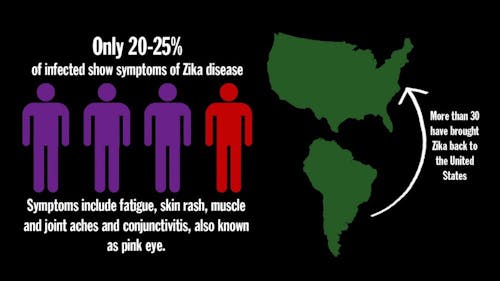Zika virus spreads across South America, raises alarm

Women in some South and Central American countries are being warned against having children due to the Zika virus, according to the New York Times.
Virus infection in pregnant women is suspected to be linked to microcephaly or a small skull and underdeveloped brain in children, said Clifton Lacy, director of the Rutgers Institute for Emergency Preparedness and Homeland Security and a research professor in the Department of Civil and Environmental Engineering.
The Zika virus is from a family of viruses that includes West Nile, Dengue and Yellow Fever. The virus is named after the forest in Uganda where it was first discovered, he said in an email.
Only 20 to 25 percent of infected people show symptoms such as fatigue, skin rash, muscle and joint aches and conjunctivitis, also known as "pink eye."
Areas with an increased number of cases of microcephaly also had an increased incidence of Guillain-Barre syndrome, a progressive paralysis that patients usually recover from, Lacy said.
“The symptoms last only two to seven days. The virus is detected in the blood for only a few days, and most people are free of a circulating virus in about a week,” he said.
The virus can be transmitted through blood transfusion or a bite from a mosquito that has the virus from an infected person, he said.
These species of mosquitoes are found throughout the Americas, including parts of the United States, according to the Centers for Disease Control and Prevention (CDC) website.
The CDC has issued a travel alert to the Caribbean, South America, Central America, Cape Verde, Samoa and Mexico. More than 30 people have already brought the disease back with them to the United States, he said.
There is no vaccine or specific treatment available to prevent infection. Those infected by the Zika virus are treated with rest, fluids and acetaminophen, Lacy said.
People in areas where mosquitoes are common should be aware of the virus’s threat, he said. Insect repellent, long sleeved clothing and physical barriers such as doors and window screens can prevent bites, he said.
Efforts are underway to develop better diagnostic tests, vaccines and antiviral medication, he said. Steps are also being taken to remove breeding sites, share accurate and timely information about the disease and reduce contact between mosquitoes and people.
The World Health Organization will hold an emergency committee in Geneva to discuss whether the situation should be declared a public health emergency, he said.
“Fortunately, the most vulnerable areas in the U.S. have air conditioning and mosquito control programs,” he said. “The primary form of prevention of the disease is protection against mosquito bites.”
___
Harshel Patel is a School of Arts and Sciences sophomore majoring in molecular biology and biochemistry. He runs the Science section of The Daily Targum. He can be found on Twitter @harshel_p.



